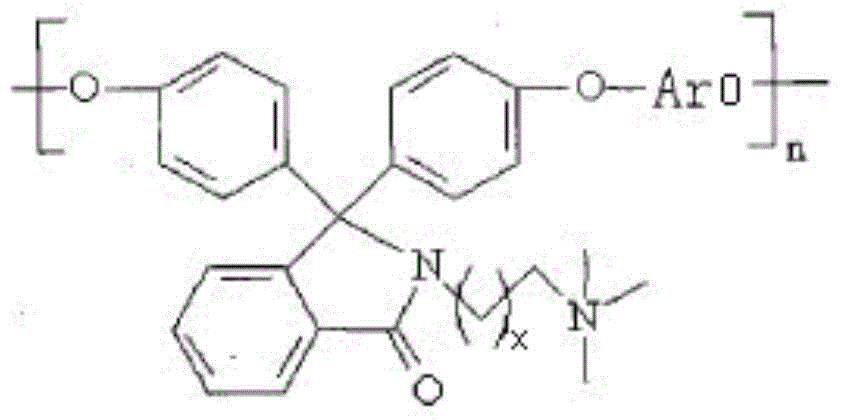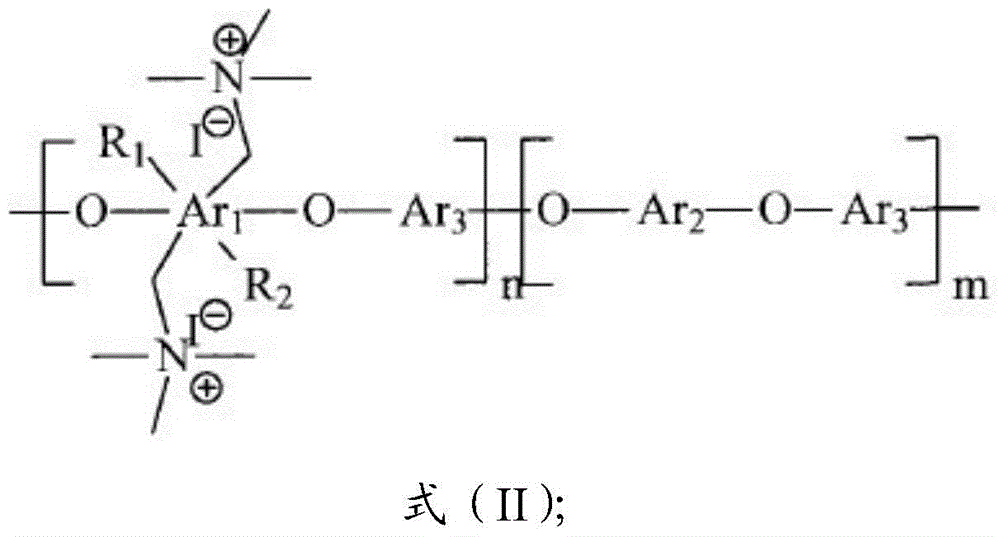Ultrafiltration membrane and preparation method thereof
A technology for the preparation of ultrafiltration membranes and additives, applied in chemical instruments and methods, membrane technology, semi-permeable membrane separation, etc. Good performance, improved hydrophilicity, easy to clean
- Summary
- Abstract
- Description
- Claims
- Application Information
AI Technical Summary
Problems solved by technology
Method used
Image
Examples
preparation example Construction
[0061] The invention provides a method for preparing an ultrafiltration membrane, comprising:
[0062] The polymer having the structure of formula (I) or formula (II) is mixed with additives, reacted, defoamed, and molded to obtain an ultrafiltration membrane;
[0063]
[0064] Wherein, x and n are degrees of polymerization, 1≤x≤20, preferably 1≤x≤10, more preferably 1≤x≤5;
[0065] 1≤n≤10000; preferably 10≤n≤8000, more preferably 50≤n≤5000;
[0066] Ar0 selected from one or both of
[0067]
[0068] Wherein, m and n are degree of polymerization, 0≤m≤10000, preferably 10≤m≤8000, more preferably 50≤m≤5000;
[0069] 1≤n≤10000, preferably 10≤n≤8000, more preferably 50≤n≤5000;
[0070] Ar 1 selected from one of
[0071] Ar 2 selected from one of
[0072] Ar 3 selected from one of
[0073] R 1 , R 2 selected from -H, One of.
[0074] In the present invention, firstly, the polymer and the additive are reacted and dissolved. The reaction temperature i...
Embodiment 1
[0096] According to the method disclosed in CN101735447A, the polymer PES-TA (n=100) as shown in formula (a) is prepared, and 100 grams of the above-mentioned polymer dried in advance, solvent N,N-dimethylacetamide (DMAC) 800 milliliters and 100 milliliters of additive ethylene glycol monomethyl ether (EGM) were sequentially added to a reaction kettle with a total volume of 2 liters, heated to 50° C., and stirred for 5 hours to completely dissolve them. After filtration and vacuum defoaming, mature in a constant temperature room at 30°C for 12 hours. Using the non-woven fabric as the base material, scrape a nascent film with a liquid layer thickness of 150 microns on it with a film scraping machine, and then immerse it in a coagulation bath deionized water to form it. After fully washing, it is wound up to obtain an ultrafiltration membrane. The method of the present invention was used to measure its performance, and the results are shown in Table 1. Table 1 shows the perform...
Embodiment 2
[0101] According to the method disclosed in CN101735447A, the polymer PES-TA (n=100) as shown in formula (a) is prepared, 100 grams of the above-mentioned polymer that has been dried in advance, 800 milliliters of solvent N-methylpyrrolidone (NMP), additives Add 50 grams of polyethylene glycol 400 (PEG-400) successively to a reaction kettle with a total volume of 2 liters, heat to 50° C., and stir for 5 hours to completely dissolve it. After filtration and vacuum defoaming, mature in a constant temperature room at 30°C for 12 hours. Using the non-woven fabric as the base material, scrape a nascent film with a liquid layer thickness of 150 microns on it with a film scraping machine, and then immerse it in a coagulation bath deionized water to form it. After fully washing, it is wound up to obtain an ultrafiltration membrane. The method of the present invention was used to measure its performance, and the results are shown in Table 2. Table 2 shows the performance measurement r...
PUM
 Login to View More
Login to View More Abstract
Description
Claims
Application Information
 Login to View More
Login to View More - R&D
- Intellectual Property
- Life Sciences
- Materials
- Tech Scout
- Unparalleled Data Quality
- Higher Quality Content
- 60% Fewer Hallucinations
Browse by: Latest US Patents, China's latest patents, Technical Efficacy Thesaurus, Application Domain, Technology Topic, Popular Technical Reports.
© 2025 PatSnap. All rights reserved.Legal|Privacy policy|Modern Slavery Act Transparency Statement|Sitemap|About US| Contact US: help@patsnap.com



